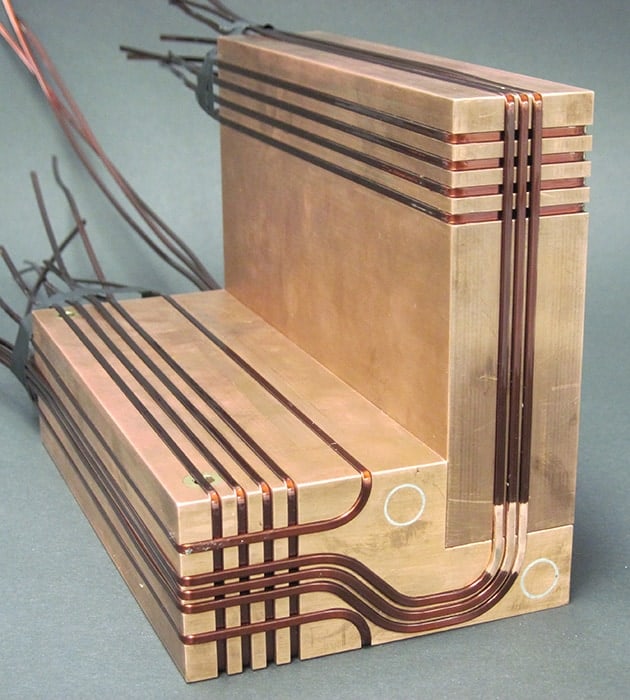
A reservoir of ultracold atoms that is topped-up continuously has been unveiled by physicists in Germany and Denmark. The system can store 38 million rubidium atoms at a temperature of 102 μK, and the team says that it could be adapted to work for a wide range of particles and trapping methods. Applications of the reservoir include using the cold atoms in metrology systems or to cool other gases or even tiny objects.
Gases of ultracold atoms and molecules are used in a wide range of applications, including atomic clocks and simulating quantum effects in solid materials. While physicists have come a long way in developing and perfecting techniques for cooling gases to temperatures as low as 50 pK, these are “one-shot” systems in which the gas is cooled in isolation and then the atoms are put to use until their numbers are exhausted or the gas is destroyed by making a measurement. In some cases, however, it would be useful to maintain a continuous reservoir of ultracold atoms that could be used to perform continuous metrology or to cool other systems.
Now, Jan Mahnke and colleagues at Leibniz Universität Hannover and Aarhus Universitet have created a continuously pumped reservoir of ultracold atoms that is integrated within an L-shaped device that is made from a copper block measuring several centimetres across (see image above). The cooling process begins in a separate device that functions as a 2D magneto-optical trap (MOT). This uses laser beams and magnetic fields to cool and guide about 10 billion rubidium-87 atoms at temperatures as low as 25 μK. Some of these atoms are then transferred to the first stage of the reservoir device, which is a 3D MOT that can store about 2 billion atoms.
Atomic evaporation
Pulses of atoms are then sent along a magnetic guide towards the reservoir trap. Each pulse contains about 84 million atoms and the process is repeated about once every second. To enter the trap, the atoms must overcome an energy barrier. Once in the trap, the atoms can collide with each other and some will lose a significant amount of energy and will remain in the trap. Others will not lose energy (or will even gain energy) and these will be able to escape from the trap. The overall effect is a cooling of the gas by a process that is analogous to evaporation.
After about 50 s, the number of atoms lost by evaporation is the same as the number gained via the pulses, and the total number of atoms in the trap reaches an equilibrium value of about 38 million atoms. The temperature also equilibrates at about 102 μK.
An important feature of the device is that the reservoir is a magnetic trap that does not contain any laser light. Indeed, the atoms must travel 20 cm from the 3D MOT to the reservoir via a U-bend, and this ensures that no light from the 3D MOT reaches the reservoir. This is particularly important for achieving the sympathetic cooling of molecules, which can very easily be heated up by absorbing stray light. The U-bend also has a differential vacuum-pumping stage, which ensures good vacuum conditions in the reservoir while allowing atoms to be loaded into the 3D MOT.
Continuous cooling
One potential metrology application is the inertial sensing of motion. This involves passing ultracold atoms through an interferometer and watching for changes in how they interfere caused by accelerations of the system. Such accelerometers could allow nuclear submarines to navigate while underwater, where they cannot use global positioning systems. Another important application, according to Mahnke, is the sympathetic cooling of atoms, molecules and even tiny solid objects. This is done by putting the system of interest in direct contact with the reservoir atoms, which takes away energy via collisions. The advantage of using a reservoir that is continuously pumped is that hot atoms escaping the reservoir will be replaced by colder ones, thereby enhancing the cooling process.
Mahnke told physicsworld.com that the team is now working to improve the performance of the system in several ways. The researchers are working to reduce the presence of eddy currents in the copper block, which degrade the magnetic fields within the traps and the magnetic guide. The team also wants to reduce the switching time of the atom-chip currents to reduce the temperature already in the pumping beam. This would lead to colder temperatures in the reservoir, bringing them close to the point where a Bose–Einstein condensate will form – about 170 nK. This would also involve lowering the energy of the entrance barrier so that only very cold atoms remain in the trap.
The reservoir is described in the Journal of Physics B: Atomic, Molecular and Optical Physics.



